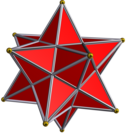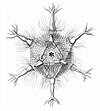This article needs additional citations for
verification. (October 2023) |
| Regular icosahedron | |
|---|---|
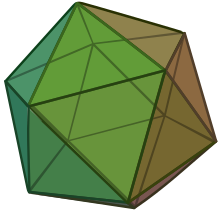 | |
| Type |
Gyroelongated bipyramid Deltahedron |
| Faces | 20 |
| Edges | 30 |
| Vertices | 12 |
| Vertex configuration | |
| Symmetry group | Icosahedral symmetry |
| Dihedral angle ( degrees) | 138.190 (approximately) |
| Dual polyhedron | Regular dodecahedron |
| Net | |
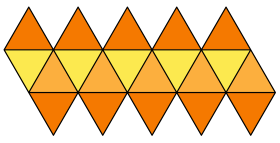 | |
In geometry, the regular icosahedron [1] (or simply icosahedron) is a convex polyhedron that can be constructed from pentagonal antiprism by attaching two pentagonal pyramids with regular faces to each of its pentagonal faces, or by putting points onto the cube. The resulting polyhedron has 20 equilateral triangles as its faces, 30 edges, and 12 vertices. It is an example of the Platonic solid and of the deltahedron. The icosahedral graph represents the skeleton of a regular icosahedron.
Many polyhedrons are constructed from the regular icosahedron. For example, most of the Kepler–Poinsot polyhedron is constructed by faceting. Some of the Johnson solids can be constructed by removing the pentagonal pyramids. The regular icosahedron has many relations with other Platonic solids, one of them is the regular dodecahedron as its dual polyhedron and has the historical background on the comparison mensuration. It also has many relations with other polytopes.
The appearance of regular icosahedron can be found in nature, such as the virus with icosahedral-shaped shells and radiolarians. Other applications of the regular icosahedron are the usage of its net in cartography, twenty-sided dice that may have been found in ancient times and role-playing games.
Construction
The regular icosahedron can be constructed like other gyroelongated bipyramids, started from a pentagonal antiprism by attaching two pentagonal pyramids with regular faces to each of its faces. These pyramids cover the pentagonal faces, replacing them with five equilateral triangles, such that the resulting polyhedron has 20 equilateral triangles as its faces. [2] This process construction is known as the gyroelongation, so the resulting polyhedron is also called gyroelongated pentagonal bipyramid. [3][ citation needed].

Another way to construct it is by putting two points on each surface of a cube. In each face, draw a segment line between the midpoints of two opposite edges and locate two points with the golden ratio distance from each midpoint. These twelve vertices describe the three mutually perpendicular planes, with edges drawn between each of them. [4] Because of the constructions above, the regular icosahedron is Platonic solid, a family of polyhedra with regular faces. A polyhedron with only equilateral triangles as faces is called a deltahedron. There are only eight different convex deltahedra, one of which is the regular icosahedron. [5]
One possible system of Cartesian coordinate for the vertices of a regular icosahedron, giving the edge length 2, is:
Properties
Mensuration

The insphere of a convex polyhedron is a sphere inside the polyhedron, touching its every face. The circumsphere of a convex polyhedron is a sphere that contains the polyhedron and touches every edge. The midsphere of a convex polyhedron is a sphere tangent to its every edge. Therefore, given that the edge length of a regular icosahedron, the radius of insphere (inradius) , the radius of circumsphere (circumradius) , and the radius of midsphere (midradius) are, respectively: [7]
The surface area of polyhedra is the sum of its every face. Therefore, the surface area of regular icosahedra equals the area of 20 equilateral triangles. The volume of a regular icosahedron is obtained by calculating the volume of all pyramids with the base of triangular faces and the height with the distance from a triangular face's centroid to the center inside the regular icosahedron, the circumradius of a regular icosahedron. [8]
The dihedral angle of a regular icosahedron can be calculated by adding the angle of pentagonal pyramids with regular faces and a pentagonal antiprism. The dihedral angle of a pentagonal antiprism and pentagonal pyramid between two adjacent triangular faces are approximately . The dihedral angle of a pentagonal antiprism between pentagon-to-triangle is , and the dihedral angle of a pentagonal pyramid between the same faces is . Therefore, for the regular icosahedron, the dihedral angle between two adjacent triangles, on the edge where the pentagonal pyramid and pentagonal antiprism are attached is . [13]
Symmetry

The rotational symmetry group of the regular icosahedron is isomorphic to the alternating group on five letters. This non- abelian simple group is the only non-trivial normal subgroup of the symmetric group on five letters. Since the Galois group of the general quintic equation is isomorphic to the symmetric group on five letters, and this normal subgroup is simple and non-abelian, the general quintic equation does not have a solution in radicals. The proof of the Abel–Ruffini theorem uses this simple fact, and Felix Klein wrote a book that made use of the theory of icosahedral symmetries to derive an analytical solution to the general quintic equation. [14]
The full symmetry group of the icosahedron (including reflections) is known as the full icosahedral group. It is isomorphic to the product of the rotational symmetry group and the group of size two, which is generated by the reflection through the center of the icosahedron.
Icosahedral graph

Every Platonic graph, including the icosahedral graph, is a polyhedral graph. This means that they are planar graphs, graphs that can be drawn in the plane without crossing its edges; and they are 3-vertex-connected, meaning that the removal of any two of its vertices leaves a connected subgraph. According to Steinitz theorem, the icosahedral graph endowed with these heretofore properties represents the skeleton of a regular icosahedron. [15]
The icosahedral graph is Hamiltonian, meaning that it contains a Hamiltonian cycle, or a cycle that visits each vertex exactly once. [16]
Related polyhedra
In other Platonic solids
Aside from comparing the mensuration between the regular icosahedron and regular dodecahedron, they are dual to each other. An icosahedron can be inscribed in a dodecahedron by placing its vertices at the face centers of the dodecahedron, and vice versa. [17]
An icosahedron can be inscribed in an octahedron by placing its 12 vertices on the 12 edges of the octahedron such that they divide each edge into its two golden sections. Because the golden sections are unequal, there are five different ways to do this consistently, so five disjoint icosahedra can be inscribed in each octahedron. [18]
An icosahedron of edge length can be inscribed in a unit-edge-length cube by placing six of its edges (3 orthogonal opposite pairs) on the square faces of the cube, centered on the face centers and parallel or perpendicular to the square's edges. [19] Because there are five times as many icosahedron edges as cube faces, there are five ways to do this consistently, so five disjoint icosahedra can be inscribed in each cube. The edge lengths of the cube and the inscribed icosahedron are in the golden ratio. [20]
Stellation
The icosahedron has a large number of stellations. Coxeter et al. (1938) stated 59 stellations were identified for the regular icosahedron. The first form is the icosahedron itself. One is a regular Kepler–Poinsot polyhedron. Three are regular compound polyhedra. [21]
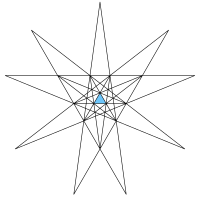 The faces of the icosahedron extended outwards as planes intersect, defining regions in space as shown by this stellation diagram of the intersections in a single plane. |

|
|

|

|

|

|

|
|
|
|
|

|

|

|

| |
|
|

|
|

|

|

|

|
Facetings
The small stellated dodecahedron, great dodecahedron, and great icosahedron are three facetings of the regular icosahedron. They share the same vertex arrangement. They all have 30 edges. The regular icosahedron and great dodecahedron share the same edge arrangement but differ in faces (triangles vs pentagons), as do the small stellated dodecahedron and great icosahedron (pentagrams vs triangles).
Diminishment
The Johnson solids are the polyhedron whose all of their faces are regular, but not uniform. This means they do not include the Archimedean solids, Catalan solids, prisms, and antiprisms. Some of them are constructed involving the removal of the part of a regular icosahedron, a process known as diminishment. They are gyroelongated pentagonal pyramid, metabidiminished icosahedron, and tridiminished icosahedron, which remove one, two, and three pentagonal pyramids from the icosahedron, respectively. [3] The similar dissected regular icosahedron has 2 adjacent vertices diminished, leaving two trapezoidal faces, and a bifastigium has 2 opposite sets of vertices removed and 4 trapezoidal faces.
Relations to the 600-cell and other 4-polytopes
The icosahedron is the dimensional analogue of the 600-cell, a regular 4-dimensional polytope. The 600-cell has icosahedral cross sections of two sizes, and each of its 120 vertices is an icosahedral pyramid; the icosahedron is the vertex figure of the 600-cell.
The unit-radius 600-cell has tetrahedral cells of edge length , 20 of which meet at each vertex to form an icosahedral pyramid (a 4-pyramid with an icosahedron as its base). Thus the 600-cell contains 120 icosahedra of edge length . The 600-cell also contains unit-edge-length cubes and unit-edge-length octahedra as interior features formed by its unit-length chords. In the unit-radius 120-cell (another regular 4-polytope which is both the dual of the 600-cell and a compound of 5 600-cells) we find all three kinds of inscribed icosahedra (in a dodecahedron, in an octahedron, and in a cube).
A semiregular 4-polytope, the snub 24-cell, has icosahedral cells.
Relations to other uniform polytopes
As has been mentioned above, the regular icosahedron is unique among the Platonic solids in possessing a dihedral angle is approximately . Thus, just as hexagons have angles not less than 120° and cannot be used as the faces of a convex regular polyhedron because such a construction would not meet the requirement that at least three faces meet at a vertex and leave a positive defect for folding in three dimensions, icosahedra cannot be used as the cells of a convex regular polychoron because, similarly, at least three cells must meet at an edge and leave a positive defect for folding in four dimensions (in general for a convex polytope in n dimensions, at least three facets must meet at a peak and leave a positive defect for folding in n-space). However, when combined with suitable cells having smaller dihedral angles, icosahedra can be used as cells in semi-regular polychora (for example the snub 24-cell), just as hexagons can be used as faces in semi-regular polyhedra (for example the truncated icosahedron). Finally, non-convex polytopes do not carry the same strict requirements as convex polytopes, and icosahedra are indeed the cells of the icosahedral 120-cell, one of the ten non-convex regular polychora.
There are distortions of the icosahedron that, while no longer regular, are nevertheless vertex-uniform. These are invariant under the same rotations as the tetrahedron, and are somewhat analogous to the snub cube and snub dodecahedron, including some forms which are chiral and some with -symmetry, i.e. have different planes of symmetry from the tetrahedron.
Relation to the 6-cube and rhombic triacontahedron
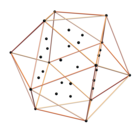
The icosahedron can be projected to 3D from the 6D 6-demicube using the same basis vectors that form the hull of the rhombic triacontahedron from the 6-cube. Shown here including the inner 20 vertices which are not connected by the 30 outer hull edges of 6D norm length . The inner vertices form a dodecahedron.
The 3D projection basis vectors [u,v,w] used are:
Applications and its natural form
Dice are the common objects with the different polyhedron, one of them is the regular icosahedron. The twenty-sided dice was found in many ancient times. One example is the dice from the Ptolemaic of Egypt, which was later the Greek letters inscribed on the faces in the period of Greece and Roman. [22] Another example was found in the treasure of Tipu Sultan, which was made out of golden and with numbers written on each face. [23] In several roleplaying games, such as Dungeons & Dragons, the twenty-sided die (labeled as d20) is commonly used in determining success or failure of an action. It may be numbered from "0" to "9" twice, in which form it usually serves as a ten-sided die ( d10); most modern versions are labeled from "1" to "20". [24] Scattergories is another board game, where the player names the categories in the card with given the set time. The naming of such categories is initially with the letters contained in every twenty-sided dice. [25]
The regular icosahedron may also appear in many fields of science. In virology, herpes virus have icosahedral shells. The outer protein shell of HIV is enclosed in a regular icosahedron, as is the head of a typical myovirus. [26] Several species of radiolarians discovered by Ernst Haeckel, described its shells as the like-shaped various regular polyhedra; one of which is Circogonia icosahedra, whose skeleton is shaped like a regular icosahedron. [27] In chemistry, the closo- carboranes are compounds with a shape resembling the regular icosahedron. [28] Icosahedral twinning also occurs in crystals, especially nanoparticles. [29] Many borides and allotropes of boron such as α- and β-rhombohedral contain boron B12 icosahedron as a basic structure unit. [30] In cartography, R. Buckminster Fuller used the net of a regular icosahedron to create a map known as Dymaxion map, by subdividing the net into triangles, followed by calculating the grid on the Earth's surface, and transferring the results from the sphere to the polyhedron. This projection was created during the time that Fuller realized that the Greenland is smaller than South America. [31] In the Thomson problem, concerning the minimum-energy configuration of charged particles on a sphere, and for the Tammes problem of constructing a spherical code maximizing the smallest distance among the points, the minimum solution known for places the points at the vertices of a regular icosahedron, inscribed in a sphere. This configuration is proven optimal for the Tammes problem, but a rigorous solution to this instance of the Thomson problem is unknown. [32]
Notes
- ^ See Jones 2003 for the pronunciation: ( /ˌaɪkɒsəˈhiːdrən, -kə-, -koʊ-/ or /aɪˌkɒsəˈhiːdrən/)
- ^ Silvester 2001, p. 140–141; Cundy 1952.
- ^ a b Berman 1971.
- ^ Cromwell 1997, p. 70.
- ^ Shavinina 2013, p. 333; Cundy 1952.
- ^ Steeb, Hardy & Tanski 2012, p. 211.
- ^ MacLean 2007, p. 43–44; Coxeter 1973, Table I(i), pp. 292–293. See column "", where is Coxeter's notation for the midradius, also noting that Coxeter uses as the edge length (see p. 2).
- ^ MacLean 2007, p. 43–44.
- ^ Herz-Fischler 2013, p. 138–140.
- ^ Simmons 2007, p. 50.
- ^ Sutton 2002, p. 55.
- ^ Numerical values for the volumes of the inscribed Platonic solids may be found in Buker & Eggleton 1969.
- ^ Johnson 1966, See table II, line 4.; MacLean 2007, p. 43–44.
- ^ Klein 1884. See icosahedral symmetry: related geometries for further history, and related symmetries on seven and eleven letters.
- ^ Bickle 2020, p. 147.
- ^ Hopkins 2004.
- ^ Herrmann & Sally 2013, p. 257.
- ^ Coxeter et al. 1938, p. 4.
- ^ Borovik 2006, pp. 8–9, §5. How to draw an icosahedron on a blackboard.
- ^ Reciprocally, the edge length of a cube inscribed in a dodecahedron is in the golden ratio to the dodecahedron's edge length. The cube's edges lie in pentagonal face planes of the dodecahedron as regular pentagon diagonals, which are always in the golden ratio to the regular pentagon's edge. When a cube is inscribed in a dodecahedron and an icosahedron is inscribed in the cube, the dodecahedron and icosahedron that do not share any vertices have the same edge length.
- ^ Coxeter et al. 1938, p. 8–26.
- ^ Smith 1958, p. 295; Minas-Nerpel 2007.
- ^ Cromwell 1997, p. 4.
- ^ "Dungeons & Dragons Dice". gmdice.com. Retrieved August 20, 2019.
- ^ Flanagan & Gregory 2015, p. 85.
- ^ Strauss & Strauss 2008, p. 35–62.
- ^ Haeckel 1904; Cromwell 1997, p. 6.
- ^ Spokoyny 2013.
- ^ Hofmeister 2004.
- ^ Dronskowski, Kikkawa & Stein 2017, p. 435–436.
- ^ Cromwell 1997, p. 7.
- ^ Whyte 1952.
References
- Berman, Martin (1971). "Regular-faced convex polyhedra". Journal of the Franklin Institute. 291 (5): 329–352. doi: 10.1016/0016-0032(71)90071-8. MR 0290245.
- Bickle, Allan (2020). Fundamentals of Graph Theory. American Mathematical Society. ISBN 9781470455491.
- Borovik, Alexandre (2006). "Coxeter Theory: The Cognitive Aspects". In Davis, Chandler; Ellers, Erich (eds.). The Coxeter Legacy. Providence, Rhode Island: American Mathematical Society. pp. 17–43. ISBN 978-0821837221.
- Buker, W. E.; Eggleton, R. B. (1969). "The Platonic Solids (Solution to problem E2053)". American Mathematical Monthly. 76 (2): 192. doi: 10.2307/2317282. JSTOR 2317282.
- Coxeter, H. S. M. (1973). "2.1 Regular polyhedra; 2.2 Reciprocation". Regular Polytopes (3rd ed.). Dover Publications. pp. 16–17. ISBN 0-486-61480-8. MR 0370327.
- Coxeter, H.S.M.; du Val, Patrick; Flather, H. T.; Petrie, J. F. (1938). The Fifty-Nine Icosahedra. Vol. 6. University of Toronto Studies (Mathematical Series).
- Cromwell, Peter R. (1997). Polyhedra. Cambridge University Press. ISBN 978-0-521-55432-9.
- Cundy, H. Martyn (1952). "Deltahedra". The Mathematical Gazette. 36 (318): 263–266. doi: 10.2307/3608204. JSTOR 3608204. S2CID 250435684.
- Dronskowski, Richard; Kikkawa, Shinichi; Stein, Andreas (2017). Handbook of Solid State Chemistry, 6 Volume Set. John Sons & Wiley. ISBN 978-3-527-69103-6.
- Flanagan, Kieran; Gregory, Dan (2015). Selfish, Scared and Stupid: Stop Fighting Human Nature and Increase Your Performance, Engagement and Influence. John Wiley & Sons. ISBN 9780730312796.
- Haeckel, E. (1904). Kunstformen der Natur (in German). See here for an online book.
- Herrmann, Diane L.; Sally, Paul J. (2013). Number, Shape, & Symmetry: An Introduction to Number Theory, Geometry, and Group Theory. CRC Press. ISBN 978-1-4665-5464-1.
- Herz-Fischler, Roger (2013). A Mathematical History of the Golden Number. Courier Dover Publications. ISBN 9780486152325.
- Hofmeister, H. (2004). "Fivefold Twinned Nanoparticles". Encyclopedia of Nanoscience and Nanotechnology. 3: 431–452.
- Hopkins, Brian (2004). "Hamiltonian paths on Platonic graphs". International Journal of Mathematics and Mathematical Sciences. 2004 (30): 1613–1616. doi: 10.1155/S0161171204307118.
- Johnson, Norman W. (1966). "Convex polyhedra with regular faces". Canadian Journal of Mathematics. 18: 169–200. doi: 10.4153/cjm-1966-021-8. MR 0185507. Zbl 0132.14603.
- Jones, Daniel (2003) [1917]. Roach, Peter; Hartmann, James; Setter, Jane (eds.). English Pronouncing Dictionary. Cambridge: Cambridge University Press. ISBN 3-12-539683-2.
-
Klein, Felix (1888).
Lectures on the ikosahedron and the solution of equations of the fifth degree. Courier Corporation.
ISBN
978-0-486-49528-6, Dover edition
{{ cite book}}: CS1 maint: postscript ( link), translated from Klein, Felix (1884). Vorlesungen über das Ikosaeder und die Auflösung der Gleichungen vom fünften Grade. Teubner. - MacLean, Kenneth J. M. (2007). A Geometric Analysis of the Platonic Solids and Other Semi-Regular Polyhedra. Loving Healing Press. ISBN 978-1-932690-99-6.
- Minas-Nerpel, Martina (2007). "A Demotic Inscribed Icosahedron from Dakhleh Oasis". The Journal of Egyptian Archaeology. 93: 137–148. doi: 10.1177/030751330709300107. JSTOR 40345834.
- Shavinina, Larisa V. (2013). The Routledge International Handbook of Innovation Education. Routledge. ISBN 978-0-203-38714-6.
- Silvester, John R. (2001). Geometry: Ancient and Modern. Oxford University Publisher.
- Simmons, George F. (2007). Calculus Gems: Brief Lives and Memorable Mathematics. Mathematical Association of America. ISBN 9780883855614.
- Smith, David E. (1958). History of Mathematics. Vol. 2. Dover Publications. ISBN 0-486-20430-8.
- Spokoyny, A. M. (2013). "New Ligand Platforms Featuring Boron-Rich Clusters as Organomimetic Sbstituents". Pure and Applied Chemistry. 85 (5): 903–919. doi: 10.1351/PAC-CON-13-01-13. PMC 3845684. PMID 24311823.
- Steinmitz, Nicole F.; Manchester, Marianne (2011). Viral Nanoparticles: Tools for Material Science and Biomedicine. Pan Stanford Publisher. ISBN 978-981-4267-94-6.
- Strauss, James H.; Strauss, Ellen G. (2008). "The Structure of Viruses". Viruses and Human Disease. Elsevier. doi: 10.1016/b978-0-12-373741-0.50005-2. ISBN 9780123737410. S2CID 80803624.
- Sutton, Daud (2002). Platonic & Archimedean Solids. Wooden Books. Bloomsbury Publishing USA. ISBN 9780802713865.
- Steeb, Willi-hans; Hardy, Yorick; Tanski, Igor (2012). Problems And Solutions For Groups, Lie Groups, Lie Algebras With Applications. World Scientific Publishing Company. ISBN 9789813104112.
- Whyte, L. L. (1952). "Unique arrangements of points on a sphere". The American Mathematical Monthly. 59 (9): 606–611. doi: 10.1080/00029890.1952.11988207. JSTOR 2306764. MR 0050303.
External links
- Klitzing, Richard. "3D convex uniform polyhedra x3o5o – ike".
- Hartley, Michael. "Dr Mike's Math Games for Kids".
- K.J.M. MacLean, A Geometric Analysis of the Five Platonic Solids and Other Semi-Regular Polyhedra
- Virtual Reality Polyhedra The Encyclopedia of Polyhedra
- Tulane.edu A discussion of viral structure and the icosahedron
- Origami Polyhedra – Models made with Modular Origami
- Video of icosahedral mirror sculpture
- [1] Principle of virus architecture
| Notable stellations of the icosahedron | |||||||||
| Regular | Uniform duals | Regular compounds | Regular star | Others | |||||
| (Convex) icosahedron | Small triambic icosahedron | Medial triambic icosahedron | Great triambic icosahedron | Compound of five octahedra | Compound of five tetrahedra | Compound of ten tetrahedra | Great icosahedron | Excavated dodecahedron | Final stellation |
|---|---|---|---|---|---|---|---|---|---|

|

|

|
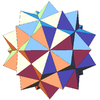
|
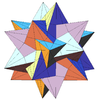
|

|

|
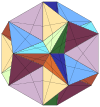
|

| |
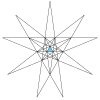
|

|

|

|

|

|

|

|

| |
| The stellation process on the icosahedron creates a number of related polyhedra and compounds with icosahedral symmetry. | |||||||||




















